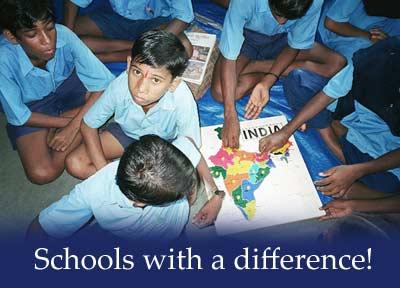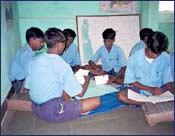
Part I: A school at the pada
When the Vidhayak Sansad, a non-government organisation working to eradicate child labour and promote literacy, discovered 12,000 children in Thane district were not going to school, it set up mukta shalas (free schools) in the Adivasi padas.
It also started bhonga shalas (migrating schools), based on the axiom that if the students can't come to school, then the school must go to the students.
There are about 800 brick kilns in Thane district, supplying bricks to Mumbai's expanding housing industry. These kilns are notorious for employing child labour: a 1998 Vidhayak Sansad study revealed 25,000 children were employed in the brick kilns in Thane district alone, most of them from the lowest strata of society.The brick kilns are active from November to April, after the monsoon and before water runs out in the summer. Bhonga shalas run from December to April. In these six months, specially trained teachers give the students basic education with special emphasis on mathematics and writing skills, which are the students' weakest areas.
"The bhonga shala is primarily for children who migrate along with their parents in search of jobs," said Anand Pawar of the Vidhayak Sansad.
While there are no bhonga shalas currently underway, about 100 young men and women who will teach at these shalas are undergoing training at the Vidhayak Sansad's sprawling campus at Usgaon Dongri in Thane district. After two months of training, they will spread out over the district, creating schools where they teach.
"Bhonga shalas were started in 1996 when a Vidhayak Sansad study found 3,000 children working in brick kilns in Thane district," says Pawar.
A Vidhayak Sansad information brochure points out that starting the bhonga shalas was not an easy task: brick kiln owners often drove away the teachers or refused them space to teach the children; parents were not initially keen to send their children to school, they wanted them to either work or help with household tasks; funding from government schemes did not arrive on time.
Despite the difficulties, there is a measure of success."From 60 schools in 1996, we are now down to 20 because the other students have been placed in regular government schools," says Pawar proudly.
Shibir shala
 On the Vidhayak Sansad campus is the shibir shala (campus school), again a novel concept. This is a school for slightly older children who have either never been to school or who dropped out early and thus reverted to illiteracy.
On the Vidhayak Sansad campus is the shibir shala (campus school), again a novel concept. This is a school for slightly older children who have either never been to school or who dropped out early and thus reverted to illiteracy.
"What happens is that such children, as they get older, feel too shy to sit in classes with younger children even if they want to resume studies," says Vidyulata Pandit, director, Vidhayak Sansad.
The first thing that hits you about the shibir shala, located on the Vidhayak Sansad premises at Usgaon Dongri, is that there are only two class levels, Class 4 and Class 7, each split into sections like Class 7A, 7B, 7C and 7D.
"This is to make a student feel that he is in class 4 or 7, even if what we teach him is meant for as student of a lower class," said headmistress Vijaya Patil.
The shibir shala is ambitious -- its aim is to make an illiterate child a class 7 student in just three years. There are no vacations at this residential school: just three one-week breaks -- for Ganesh Chaturthi, Diwali and summer. While the stress is on mathematics and writing skills, students are also taught English and various vocational skills such as music, farming techniques, arts, crafts, etc.
Janardhan Bhoire, who teaches English, said the students who come to the school are smart and worldly wise even though they are illiterate. Some have never held a pencil in their hands.
"They are weakest in math and writing," he said. "Like in any other school, some students are better than others. So we encourage them to study further and provide the weaker ones more of vocational training with courses in music, drama, painting, etc. We also teach them modern farming techniques."
Professionals from different fields are invited to lecture to the students about different professions and life beyond the villages in order to broaden their horizons and equip them to face the outside world.
The first difficulty the students face once they join the shala is the prospect of sitting in a classroom for long hours. "All these years they have been free to roam around. Suddenly they have to sit for hours on end and find that difficult. So we help out by organising field trips and taking them out. After a few weeks, the students themselves tell us to return to the classroom for studies," says Patil.
At present, the school, which started four years ago, has 105 students, 42 of whom are girls. Some of the children have enrolled in the school only a few months ago. The Vidhayak Sansad conducts surveys of the villages and padas in the surrounding areas after which it attempts to convince parents to send their illiterate children to school. The students are asked to name both their parents in the school's registers, instead of following the government style where only the name of the father is required.
While the medium of instruction is Marathi, Bhoire points out that since many of the teachers are Adivasis, they often break into the local dialect to communicate better.
But the final proof of the pudding is in the eating. "Last year, 10 of our students sat for the government's class 7 exams. All of them passed," Bhoire says proudly. This year, many more such students who, but for the Vidhayak Sansad's amazing effort, might have been out in the fields, working to survive even as urban Indians prospered, will sit for the exams.
The Constitution states that primary education up to the age of 14 is an obligation upon the government, a directive principle that was reiterated by the Supreme Court. Yet, it is clear that the government, and thereby the people, of India have failed in this task. India still has the world's largest number of illiterates.
But some citizens have, in their own way, sought to, and made, a difference.
Part I: A school at the pada
Photographs: Amberish K Diwanji
Image: Rahil Shaikh






 © 2025
© 2025